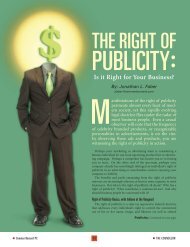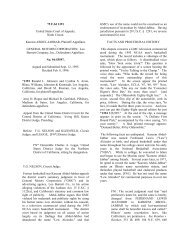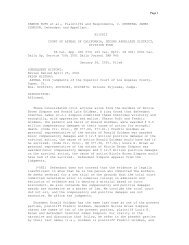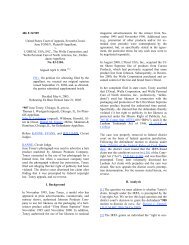Johnny Carson v. Here's Johnny Portable Toilets ... - Right Of Publicity
Johnny Carson v. Here's Johnny Portable Toilets ... - Right Of Publicity
Johnny Carson v. Here's Johnny Portable Toilets ... - Right Of Publicity
Create successful ePaper yourself
Turn your PDF publications into a flip-book with our unique Google optimized e-Paper software.
cursory inspection of the picture suggests that thefacial characteristics of the man are those of Ali. Thecourt stated: "The cheekbones, broad nose andwideset brown eyes, together with the distinctivesmile and close cropped black hair are recognizableas the features of ... [Ali]." Ali supra, 726.Augmenting this likeness and reinforcing itsidentification with Ali was the context in which thelikeness appeared--a boxing ring. The court foundthat identification of the individual depicted as Aliwas further implied by the accompanying phrase "theGreatest." Id. 727. Based on these facts, the courthad no difficulty concluding that the drawing wasAli's portrait or picture. See id. 726. To the extentthe majority uses the phrase "the Greatest" to supportis position that the right of publicity encompassesphrases or other things which are merely associatedwith an individual, they misstate the law of Ali. Onceagain, Ali is clearly a "likeness" case. To the extentthe likeness was not a photographic one free from allambiguity, identification with Muhammad Ali wasreinforced by context and a phrase "the Greatest"stated by Ali about himself. The result in that case isso dependent on the identifying features in thedrawing and the boxing context in which the man isportrayed that the phrase "the Greatest" may not besevered from this whole and the legal propositionsdeveloped by the Ali court in response to the wholeapplied to the phrase alone. To be analogous, alikeness of <strong>Johnny</strong> <strong>Carson</strong> would be required inaddition to the words "<strong>Here's</strong> <strong>Johnny</strong>" suggesting*844 the context of "The Tonight Show" or the Alicourt would have to have enjoined all others fromusing the phrase "the Greatest." In short, Ali doesnot support the majority's holding.Motschenbacher, the third case cited by the majority,is an "identifying characteristics" case.Motschenbacher, a professional driver of racing carswho is internationally known, sought protection inthe right of publicity for the unauthorized use of aphotograph of his racing car, slightly altered, in atelevised cigarette commercial. Although he was infact driving the car at the time it was photographed,his facial features are not visible in the commercial.Motschenbacher, supra, 822. The Ninth Circuitfound as a matter of California law, that the right ofpublicity extended to protect the unauthorized use ofphotographs of Motschenbacher's racing car as one ofhis identifying characteristics. Identifyingcharacteristics, such as Motschenbacher's racing car,are not synonymous with phrases or other thingswhich are merely associated with an individual. InMotschenbacher, the Ninth Circuit determined thatthe car driver had "consistently 'individualized' hiscars to set them apart from those of other drivers andto make them more readily identifiable as his own."Id. Since 1966, each car had a distinctive narrowwhite pinstripe appearing on no other car. Thisdecoration has always been in the same place on thecar bodies, which have uniformly been red. Inaddition, his racing number "11" has always beenagainst an oval background in contrast to the circularwhite background used by other drivers. Id. In thecommercial, the photo of Motschenbacher's car wasaltered so that the number "11" was changed to "71,"a spoiler with the name "Winston" was added, andother advertisements removed. The remainder of theindividualized decorations remained the same. Id.Despite these alterations, the Ninth Circuitdetermined that car possessed identifyingcharacteristics peculiar to Motschenbacher. Id. 827.This case is factually and legally distinguishable fromthe case on appeal. Motschenbacher's racing car wasnot merely associated with him but was the vehicle,literally and figuratively, by which he achieved hisfame. The identifying characteristics, in the form ofseveral decorations peculiar to his car, were theproduct of his personal time, energy, effort andexpense and as such are inextricably interwoven withhim as his individual work product, rather than beingmerely associated with him. Furthermore, thenumber and combination of the peculiar decorationson his cars results in a set of identifyingcharacteristics, which although inanimate, are uniqueenough to resist duplication other than by intentionalcopying. This uniqueness provides notice to thepublic of what is claimed as part of his publicityright, as does an individual's name, likeness or actualperformance, and narrowly limits the scope of hismonopoly. In contrast to Motschenbacher, <strong>Johnny</strong><strong>Carson</strong>'s fame as a comedian and talk show host isseverable from the phrase with which he isassociated, "<strong>Here's</strong> <strong>Johnny</strong>." This phrase is not<strong>Johnny</strong> <strong>Carson</strong>'s "thumbprint"; it is not his workproduct; it is not original; it is a common, simplecombination of a direct object, a contracted verb anda common first name; divorced from context, it istwo dimensional and ambiguous. It can hardly besaid to be a symbol or synthesis, i.e., a tangible"expression" of the "idea," of <strong>Johnny</strong> <strong>Carson</strong> thecomedian and talk show host, as Motschenbacher'sracing car was the tangible expression of the man.Finally, Lombardo v. Doyle, Dane & Bernbach, Inc.,58 A.D.2d 620, 396 N.Y.S.2d 661 (App.Div.1977),which although not cited by the majority is discussedby a number of the commentators with the cases citedby the majority, does not go so far as to extend theright of publicity to phrases or things which aremerely associated with an individual. In Lombardo,an advertising agency and foreign automobile







